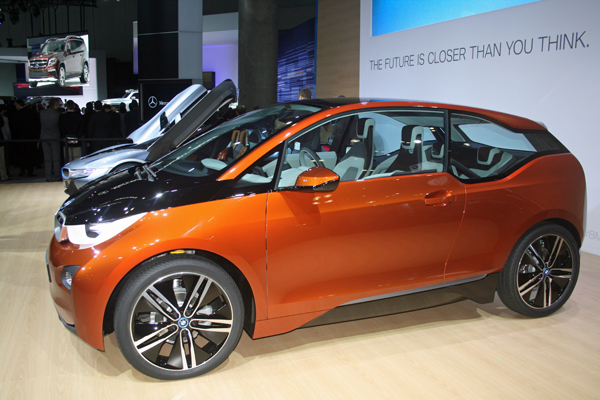BMW has driven a long road towards the development of production-ready electric vehicles for its worldwide audience. Looking back over our archives, we note the first instance we reported on being word of the German automaker testing out its ActiveE electric vehicle concept back in December of 2009. It eventually consolidated its work in this area under its “i” brand, and now the first electric car is ready for market – enter the 2014 i3.

The company announced a ton of technical details around a vehicle characterized as offering “customers zero driving emission mobility in a premium car package.” Here are the key take away ones you’ll want to mull over as you wait for an official price announcement from BMW:
- 110 lb electric motor generates output of 170hp (125 kW) and peak torque of 184 lb-ft (250 Nm)
- motor’s average power consumption of around 0.13 kilowatt hours per kilometer (0.21 kilowatt hours per mile) in the New European Driving Cycle
- 0 to 35 mph (0 – 60 km/h) in about 3.5 seconds and 0 to 60 mph (0-100 km/h) in approximately seven seconds
- top speed limited to 93 mph (150 km/h)
- lithium ion battery consists of eight modules (each with 12 individual cells), which together produce a rated voltage of 360 volts and generate approximately 22 kilowatt hours of energy
- battery enables a driving range a range of 80 – 100 miles (130 – 160 km) in everyday driving, which can be increased by use of special driving modes
- brake energy recuperation through the motor also increases the range by as much as 20 percent
- optional 650cc two-cylinder gasoline engine, used in a range extended function, increases the car’s maximum range in day-to-day driving to around 160 – 180 miles (250 – 300 km)
- when plugged into a public DC fast-charging station (50 kW) it only takes about 20 minutes for the battery to reach 80 percent capacity
Of all the things listed around technical specifications, the inclusion of an optional range extending gas engine is perhaps one of the most fascinating. Working in much the same way the Chevy Volt does, it is mounted immediately adjacent to the electric motor and fed by a 2.4 gallon (nine liter) fuel tank located in the front section of the car. It does not power the vehicle specifically, but rather provides energy to a generator which produces electricity that in turn is used to maintain “the charge of the lithium-ion battery at a constant level while on the move as soon as it dips below a certain value.”
Given that this is an electric car that will likely command a hefty price tag, BMW has tossed in a major suite of features to keep those in the i3 informed and entertained. These include “navigation services specially developed to enhance electric mobility alongside familiar features including the Concierge Services information facility and the intelligent BMW Assist eCall” and a smartphone application which provides a wealth of information related to the car.